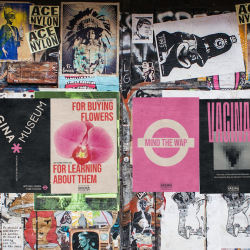The cultural output of the 1920s was a society-wide response to the piling up of changes that affected our status quo. A century later, as once again one black swan event follows another in a relentless parade of horrifying surprises, can we finally catch a break by looking at the way we responded before and, maybe, thinking about what worked?

In Vienna’s Leopold Museum a small image packs one of art’s most breathtaking punches. A tiny sketch of Edith Schiele (right), the pregnant wife of artist Egon Schiele, shows the subject on the day of her death from the Spanish Flu. Her husband died of the same virus just three days later aged 28, having pre-empted some of western art’s greatest changes through work created during the most widespread and rapid period of social, political and technological change ever to have affected Europe.
The enduring nature of his work, as attractive to each new generation of iconoclasts as Camus, Kerouac or Burroughs, comes from his ability to track and parse the changes of society through the lens of a unique and fearless aesthetic. On Schiele’s death this process did not stop; the creative minds at the forefront of culture continued to fulfil what some suggest is the role of the artist in society by responding and processing change on behalf of us all. But how they responded changed in some noticeable ways.

The flu outbreak of 1918 — Laura Spinney argued in her much rediscovered book on the subject Pale Rider — changed culture as much, or possibly even more than the First World War as, sodden with grief and enervated by the ceaseless battering of multiple traumas, the world reeled into a new decade. Those artists who survived did what artists do, and processed the changes around them through their work, responding with everything from a rejection of the romanticism of impressionism in painting to a rejection of decoration in architecture, to a rejection of melody in classical music. Rejection marked the era and it may be that as we face a stacking up of seemingly unbearable challenges, rejection will mark our cultural responses in the same way.
Spinney argued that the creatives of the era immediately post the Spanish Flu outbreak, came to associate the failure of their societies to protect them with the creative choices those societies had made. The war and the virus had shown that they could override any of the certainties that societies had invested in, and cultural embodiments of that certainty, like artworks, buildings and music became almost repugnant symbols of our former misguided thinking and effort. And there is no doubt that a contemporary take on this effect is under-way, as wonderfully encapsulated in the idea of the Vibe Shift conceptualised by Séan Monaghan that went viral in Allison P. Davis’ piece.
This week’s launches of Kendrick Lamar’s United in Grief and Arcade Fire’s The Age of Anxiety show that, as the Viennese had Schiele, we too have hugely popular, highly accomplished artists helping us to navigate the terrifying uncertainty of our times. The vibe shift they demonstrate, like the output of artists as varied as Chloe Cherry, Balenciaga and Cory Archangel, at one time embraces and rejects our collective obsession with the codes of the early and mid 2000s.
This push-me-pull-you tension celebrates the optimism of the era, as in a recent FARFETCH campaign (above) featuring Kim Cattrall and Josh Hartnett, whilst hating ourselves for buying into an era that seems to have failed us, best summed up by the now famous i-D Magazine piece on the ‘dissociated pout’ now adopted by noughties vintage-clad celebrities worldwide, distancing themselves from the comforting nostalgia of the very aesthetic they are presenting.
The peculiar quality of seeking comfort from a culture that we know to be bad for us, and the self-loathing that can come from it, marked some of the most recognisable cultural outputs of the decades that followed the First World War. From the amphetamine-fuelled flappers and Waugh’s Bright Young Things to Freud’s development of the idea of the death drive, or Todestreib and the Italian Futurists, the seeds of a chaotic future were sown in these melancholic years.
The strain of nihilism that underscores some of the cultural currents we find ourselves swimming in may yet show that the only response to ongoing cataclysm is a resigned ennui (and perhaps a smudgy eye-liner look), but it is worth considering that whilst the 1920s rejection of the before times had some extraordinary benefits — not least in the ending of pernicious colonialism and the rise of workers’ rights movements, the wholesale rejection of what had gone before the Spanish Flu was not, in the end, brilliantly helpful, eventually leading as it did to World War 2.
Whilst it may be instinctive to reject the past, seeing all choices as leading to our current parlous state, our discernment is required now, to enable us to select the cultural tools for a sustainable and positive future.
Disclosure: Hannah provides strategic communications consultancy for FARFETCH.
Featured image: pawel szvmanski / Unsplash































